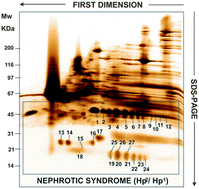Protein–protein interaction heterogeneity of plasma apolipoprotein A1 in nephrotic syndrome†
Abstract

- This article is part of the themed collection: Italian Proteomics Association
* Corresponding authors
a
Divisione di Nefrologia e Laboratorio di Fisiopatologia dell’Uremia, G. Gaslini Children’s Hospital, Genova, Italia
E-mail:
labnefro@ospedale-gaslini.ge.it
Fax: +39 010-395214
Tel: +39 010-380742
b Mass Spectrometry Core Facility, G. Gaslini Children’s Hospital, Genova, Italia
c IRCCS-Fondazione Santa Lucia, Roma, Italia
d Centre of Investigation on Aging (CeSI), Department of Biomedical Sciences, University “G. D’Annunzio”, Chieti, Italia
e Renal Child Foundation, c/o G. Gaslini Children’s Hospital, Genova, Italia
f Department of Internal Medicine, University of Rome “Tor Vergata”, Roma, Italia

 Please wait while we load your content...
Something went wrong. Try again?
Please wait while we load your content...
Something went wrong. Try again?
L. Santucci, G. Candiano, A. Petretto, B. Pavone, M. Bruschi, R. Gusmano, G. Federici, A. Urbani and G. M. Ghiggeri, Mol. BioSyst., 2011, 7, 659 DOI: 10.1039/C0MB00127A
To request permission to reproduce material from this article, please go to the Copyright Clearance Center request page.
If you are an author contributing to an RSC publication, you do not need to request permission provided correct acknowledgement is given.
If you are the author of this article, you do not need to request permission to reproduce figures and diagrams provided correct acknowledgement is given. If you want to reproduce the whole article in a third-party publication (excluding your thesis/dissertation for which permission is not required) please go to the Copyright Clearance Center request page.
Read more about how to correctly acknowledge RSC content.
 Fetching data from CrossRef.
Fetching data from CrossRef.
This may take some time to load.
Loading related content
